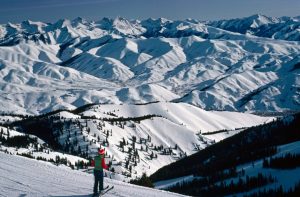Michael Ames
Sun Valley & COVID-19
April 3, 2020Why an Idaho Ski Destination Has One of the Highest COVID-19 Infection Rates in the Nation
Blaine County, Idaho, for example, which is roughly the size of Delaware, has just three hundred and ninety-nine confirmed cases and two deaths. But, with approximately twenty-two thousand full-time residents, the county’s infection rate is now the highest in the nation—greater even than those of New York’s Westchester and Rockland counties, and possibly on par with earlier pandemic epicenters in northern Italy and Wuhan, China. And, as in Italy, the situation is exacerbated in the aging resort towns of Ketchum and Sun Valley, where the average ages of residents are forty-six and sixty, respectively.
Idaho’s doctors and nurses face the greatest danger. More than fifty health-care workers have tested positive in the state’s South Central Health District, about forty of whom work for the St. Luke’s hospital system in Blaine County and Twin Falls to the south. Jesse Vanderhoof, a nurse at St. Luke’s hospital, in Ketchum, was administering nasal swabs at a drive-up testing site before he became sick. As his condition deteriorated, on March 24th, his wife dropped him back at the E.R.; hours later, she received a call saying that her previously healthy, thirty-nine-year-old husband had suffered a seizure and was boarded onto a life flight bound for Boise. He was put on a ventilator for several days before regaining the strength to breathe on his own.
Brent Russell, one of two E.R. physicians at St. Luke’s in Ketchum who tested positive, battled a hundred-and-four-degree fever with shaking chills; he would awaken in the middle of the night, unable to catch his breath. Russell wrote a letter to the local Idaho Mountain Express pleading with a community that, in his view, was either unable or unwilling to adapt to the new rules of the pandemic. “People were not taking this seriously,” he told me. “I would look out the windows of my house and see groups of people talking and congregating in the street.” As his wife, son, niece, and nephew all came down with symptoms of covid-19, Russell applauded Governor Little’s abrupt stay-at-home order, a decision that caught many by surprise in a state known as a refuge for anti-government individualists. “We need a heavy hand right now,” Russell said. “We need all forces thrown at stopping this thing.”
A ski resort is, in many ways, an ideal breeding ground for an epidemic. Skiing and snowboarding may look from a distance like solitary pursuits; the helmets, goggles, and neck warmers may be assumed to function like alpine hazmat suits. But, at major resorts, stretches of brisk, wintry liberation on the slopes are interrupted by long chairlift and gondola rides, during which people sit shoulder to shoulder and knee to knee with a perpetually rotating cast of strangers. The National Brotherhood may not have brought the virus to Idaho, but it did bring the party, and, in ski towns across America and the rest of the world this winter, the two have gone hand in hand. Ski-resort areas in California, Colorado, and elsewhere “show higher infection rates than more densely populated cities nearby,” Adventure Journal noted, including Mono County, California, the home of Mammoth Mountain Ski Area, which now has the highest per-capita rate of covid-19 in the state. In Europe, several governments tracked hundreds of coronavirus cases to one Austrian ski town, with some epidemiological reports identifying beer-pong tables as a potential source of infection. In Mexico, the chairman of the Mexican Stock Exchange tested positive after returning from a ski trip to Colorado’s Vail resort.
Tensions between big-spending outsiders and the local workforce that relies on their spending define life in any vacation town. But, in a pandemic, the calculus is changing. In the Idaho Mountain Express classifieds, one local summed up the situation in Biblical terms: “To everyone coming here to ‘ride out the storm,’ please stay in for 2 weeks before you immerse yourself in our town. Please don’t buy a 3-month supply of groceries, leaving little for the rest of us. Don’t be a plague of locusts.”
[Full Article]
Bowe.
December 15, 2019“American Cipher: Bowe Bergdahl”
Season 2019 Episode 10 | 28m 47s
Marcia Franklin talks with Michael Ames about his book, “American Cipher: Bowe Bergdahl and the U.S. Tragedy in Afghanistan.” Bergdahl was a soldier from Hailey, Idaho, who walked off his base in Afghanistan in 2009 and was captured by the Taliban. He was held and tortured for five years. Ames and his co-author delve into Bergdahl’s childhood and the politics surrounding the search for him.
[Aired on Dec. 13, 2019
https://video.idahoptv.org/video/american-cipher-bowe-bergdahl-aed8vg/
AT WAR WITH THE TRUTH
U.S. officials constantly said they were making progress. They were not, and they knew it, an exclusive Post investigation found.
The Afghanistan papers
The Secret History of the War
“We were devoid of a fundamental understanding of Afghanistan–we didn’t know what we were doing.” Douglas Lute, a three-star Army general who served as the White House’s Afghan war czar during the Bush and Obama administrations, told government interviewers in 2015. He added: “What are trying to do here? We didn’t have the foggiest notion of what we were undertaking.”
With most speaking on the assumption that their remarks would not become public, U.S. officials acknowledged that their warfighting strategies were fatally flawed and that Washington wasted enormous sums of money trying to remake Afghanistan into a modern nation.
The interviews also highlight the U.S. government’s botched attempts to curtail runaway corruption, build a competent Afghan army and police force, and put a dent in Afghanistan’s thriving opium trade.
The U.S. government has not carried out a comprehensive accounting of how much ithas spent on the war in Afghanistan, but the costs are staggering.




